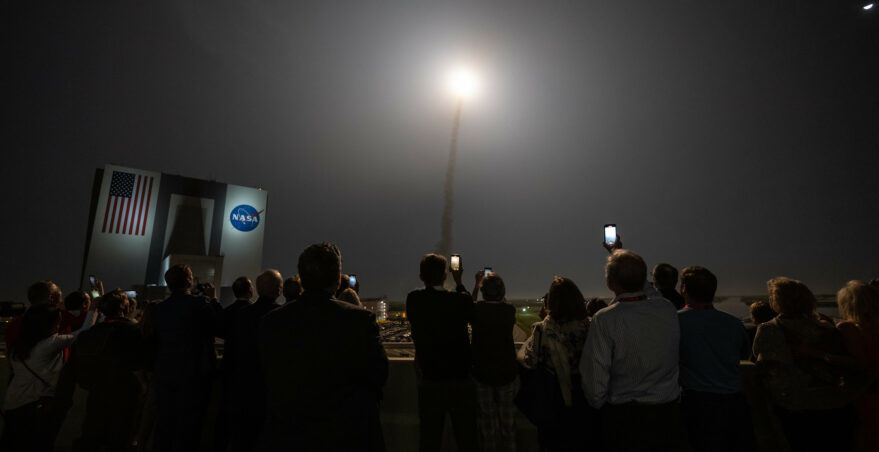As U.S. adversaries seek to militarize space, SLS’s heavy-lift capability makes it a unique entity for NASA and national security. Robust congressional support for SLS, NASA’s near-term Artemis missions and future configurations is more important than ever.
In the early morning of Nov. 16, 2022, America reaffirmed its role as the leader in space. The launch of the Space Launch System (SLS) marks the beginning of this new era space race in which the stakes have never been higher. As the most powerful rocket ever built, and now flown, the SLS will be the workhorse for Artemis and America’s triumphant return to the Moon and beyond.
It’s important to remember the journey of how we got here. After the success of the Space Shuttle Program and a slump in American space activity, it was time for NASA to look forward. From there, many of our nation’s space leaders, including NASA, Congress, and Industry, joined forces to develop the Space Launch System. Building from existing technology and capabilities, the SLS not only revitalized American space ambitions for the 21st century, but also saved countless jobs and sustained our workforce for the challenges of today.
As the U.S. faces down existential adversaries unseen since the Cold War, this sustainment has proven vital as we seek to counter a rising China and a resurgent Russia. In this new era, STEM talent is a critical currency, and ensuring that the best and the brightest assisting these programs like Artemis remain at NASA and within our American space industry is of paramount importance. Additionally, as these adversaries seek to militarize space, SLS’s heavy-lift capability not only makes it a unique entity for NASA, but also for national security as well.
Therefore, it will be more important than ever for Congress to continue its robust support and funding for not just SLS and the near-term Artemis missions but also its future configurations and infrastructure. Specifically, Block 1B, Block 2, and the Mobile Launcher 2 Platform — all crucial aspects needed for the broader Artemis program to succeed. Without these items, other aspects of Artemis, including Gateway, and our efforts for sustained lunar habitation, may be at great risk.
Additionally, without these components, the U.S. risks ceding more ground to nations like China, who seek to fill any gaps we may leave open. The SLS will be a long-term national asset worth leveraging across the board for our American space enterprise.
As outlined during my speech at the International Space Station Research & Development Conference this past summer, in the grander enterprise for American space, I acknowledged that we have an array of great expertise displaying our capabilities in this domain. Redundancy is welcome in this realm.
However, even as we celebrate this momentous achievement, our ambitions cannot waiver. While we visited the Moon during the Apollo era, we’re returning in the Artemis era not only to stay, but to go onward to Mars. In doing so, we must remain focused on the objective and remain steadfast in our development for a safe and sustainable journey to the red planet within the next decade. It took several years and countless hours of work to accomplish the first steps of Artemis we’ve just seen. If we are to land an American on Mars within the 2030s, we must plow ahead in preparation for that mission simultaneously with our current endeavors.
This means we need to see heavier investment into technologies like nuclear thermal propulsion to ensure we can reach the planet in an effective time. It means further development of habitation capabilities not only beneficial for lunar sustainment, but also for astronauts endearing the harsh environment of space during travel.
It also means the development of in-space manufacturing and robotic capabilities to help fill the gaps where humans may be unable to perform. All of this will ultimately culminate in the development and construction of the Mars Transit Vehicle that will be constructed and docked with the Lunar Gateway prior to its multi-year journey to Mars. NASA has always paved the way in achieving what some may see as impossible.
Going into the next Congress, I look forward to continuing not only my support for the Space Launch System, but our vast American space enterprise overall, and ensuring that this new era remains an American-led century in space.
U.S. Rep. Robert Aderholt (R-Ala.) serves on the House Appropriations commerce, science, justice committee, which oversees NASA. His congressional district includes parts of Huntsville and Decatur, rocket manufacturing hubs home to NASA Marshall Space Flight Center and the SLS program.
